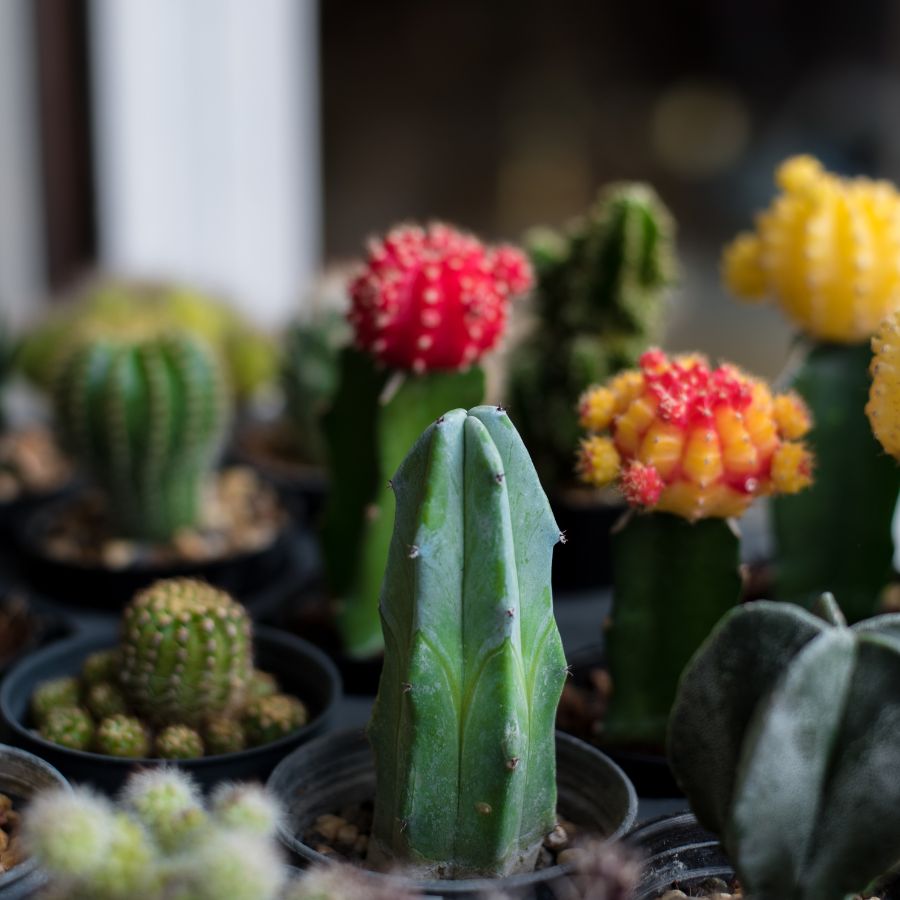Cacti
Most cacti bear spines or hair and are shaped like paddles, balls, or obelisks.
Light
Cacti require four to six hours of bright sunlight daily. However, some species of both desert and forest cactus can burn in direct sunlight. Locate your cactus near a sunny window, and opt for a spot that receives filtered bright light in the summer and direct light (like a south- or west-facing window) in the winter. You can move your cactus outdoors during the summer to provide ample light, but do so only when night temperatures warm to 50 degrees Fahrenheit or above.
Soil
Desert cactus grows best in a fast-draining soil mix designed specifically formulated for cacti. They also grow well in regular potting soil amended with sand, pebbles, or perlite to increase drainage and aeration.
Water
During the spring and summer, when your cactus is actively growing and blooming, give it a hearty drink approximately every ten days, allowing the water to drain thoroughly. During the winter rest period, decrease waterings to once every four weeks (up to six weeks for some desert species). The soil should be dry to the touch in between summer waterings and mostly dry in the winter.
Fertilizer
Cactus can survive some of the harshest conditions on earth. Any effort to fertilize is welcomed, but is not necessary. Some gardeners yield poor results with standard houseplant fertilizers (probably due to the improper ratio of nutrients), so seek out a specialized organic cacti fertilizer that contains more phosphorus than nitrogen. Fertilize your cactus two to three times a year, only during the growing season, and refer to the manufacturer’s recommended amounts. Reduce or eliminate fertilizer during the winter.
Pruning
Usually, a cactus doesn’t really need major pruning unless you are trying to control its growth. Removing dead or damaged parts (or removing pups or offshoots to propagate) can be done with clean, sharp garden shears as needed.
Potting and Repotting Cactus
Cacti are slow-growing plants that will rarely need repotting. Actually, many species of cacti will bloom better when they are slightly root-bound. Cacti should be repotted at the beginning of the growing season only when they need fresh soil or are suffering from rot. To do so, first, remove your plant from its current pot using a clean trowel to loosen the roots. Fill the bottom of a terra-cotta or clay pot with a fast-draining cactus potting mix. Add your plant, backfilling around the sides and taking care to cover the roots, and lightly water.
How to Get Indoor Cactus to Bloom
A blooming cactus or succulent is a treat, as most do not bloom indoors. In order to aid in the process, you’ll need to recreate the cactus’ natural habitat, which requires warm daytime temperatures and cool nighttime temperatures of 50 to 55 degrees Fahrenheit. If your house is warmer than that, you could move your plant to a garage or basement at night.
In order to flower, cacti also need to receive at least four to six hours of sunlight and the proper amount of water (but not too much!). Perhaps the most important factor for blooms is to let your cactus experience a period of dormancy, when sunlight and water are reduced. It is during this time that some forest cacti (like the Christmas cactus) bloom.
Common Problems with Indoor Cactus
The most common mistake cactus gardeners make is overwatering in the winter. This can lead to rot either at the base of the plant or at the tips where new growth appears. If the rot is advanced, it might be necessary to start a new plant from cuttings or discard the whole mother plant entirely.
Overwatered cacti can suffer from fungal rot which looks like dark, sunken spots on the stem that eventually turn mushy. Bacterial rot can also cause your cactus to ooze a black liquid. If either of these conditions presents itself, remove the affected areas of the plant and treat it with a diluted hydrogen peroxide solution.
Cacti are non toxic (but they are prickly, so don’t eat them!)


